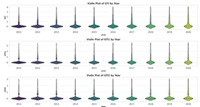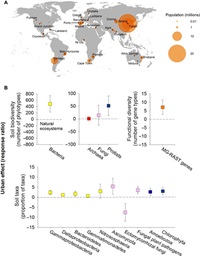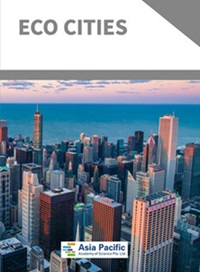

Asia Pacific Academy of Science Pte. Ltd. (APACSCI) specializes in international journal publishing. APACSCI adopts the open access publishing model and provides an important communication bridge for academic groups whose interest fields include engineering, technology, medicine, computer, mathematics, agriculture and forestry, and environment.


Enhancing HMA properties with polypropylene-based face mask integration: A qualitative comparison of wet mixing and dry mixing techniques
Vol 4, Issue 1, 2023
VIEWS - 220 (Abstract)
Abstract
In the wake of the emergence and widespread dissemination of the COVID-19 coronavirus, scientifically identified as SARSCoV-2, the utilization of medical equipment, specifically tri-layered polypropylene (PP)-based face masks, has experienced significant proliferation. The extensive adoption of single-use polymer-based face masks has raised notable environmental concerns, given their extended degradation period of up to 480 years and their substantial threat to ecosystems, particularly aquatic organisms, due to pervasive littering practices. Hence, this study is dedicated to assessing the influence of incorporating polypropylene (PP)-based face masks into asphalt formulations. The incorporation of PP-based face masks into asphalt was executed at three distinct weight percentages, employing both dry and wet mixing techniques. Comprehensive performance evaluations were carried out utilizing the Marshall test, indirect tensile fatigue test, and Hamburg wheel tracking rutting experiments and the best value for each. Remarkably, augmenting the PP content yielded improvements in both fatigue life and rutting resistance of the asphalt mixtures, and the maximum improvement was recorded at 0.3% replacement. Notably, asphalt specimens prepared using dry mixing techniques outperformed their wet mixing counterparts, demonstrating superior cohesion attributes.
Keywords
Full Text:
PDFReferences
1. Wong J, Goh QY, Tan Z, et al. Preparing for a COVID-19 pandemic: A review of operating room outbreak response measures in a large tertiary hospital in Singapore. Canadian Journal of Anaesthesia 2020; 67(6): 732–745. doi: 10.1007/s12630-020-01620-9
2. Nzediegwu C, Chang SX. Improper solid waste management increases potential for COVID-19 spread in developing countries. Resources, Conservation, and Recycling 2020; 161: 104947. doi: 10.1016/j.resconrec.2020.104947
3. Huang YT, Pan TC, Kao JJ. Performance assessment for municipal solid waste collection in Taiwan. Journal of Environmental Management 2011; 92(4): 1277–1283. doi: 10.1016/j.jenvman.2010.12.002
4. Aslani F, Deghani A, Asif Z. Development of lightweight rubberized geopolymer concrete by using polystyrene and recycled crumb-rubber aggregates. Journal of Materials in Civil Engineering 2020; 32(2). doi: 10.1061/(ASCE)MT.1943-5533.0003008
5. Abukhettala M, Fall M. Geotechnical characterization of plastic waste materials in pavement subgrade applications. Transportation Geotechnics 2021; 27: 100472. doi: 10.1016/j.trgeo.2020.100472
6. Matuschek C, Moll F, Fangerau H, et al. Face masks: Benefits and risks during the COVID-19 crisis. European Journal of Medical Research 2020; 25: 32. doi: 10.1186/s40001-020-00430-5
7. Boroujeni M, Saberian M, Li J. Environmental impacts of COVID-19 on Victoria, Australia, witnessed two waves of coronavirus. Environmental Science and Pollution Research 2021; 28: 14182–14191. doi: 10.1007/s11356-021-12556-y
8. Prata JC, Silva ALP, Walker TR, et al. COVID-19 pandemic repercussions on the use and management of plastics. Environmental Science & Technology 2020; 54(13): 7760–7765. doi: 10.1021/acs.est.0c02178
9. Royo-Bordonada MA, García-López FJ, Cortés F, Andrés Zaragoza G. Face masks in the general healthy population. Scientific and ethical issues. Gaceta Sanitaria 2022; 35(6): 580–584. doi: 10.1016/j.gaceta.2020.08.003
10. Saberian M, Li J, Kilmartin-Lynch S, Boroujeni M. Repurposing of COVID-19 single-use face masks for pavements base/subbase. Science of The Total Environment 2021; 769: 145527. doi: 10.1016/j.scitotenv.2021.145527
11. Morse S. 1.56 billion face masks pollute ocean in 2020. Available online: https://www.oceanicworldwide.com/blog/1-56-billion-face-masks-pollute-ocean-in-2020/ (accessed on 23 February 2023).
12. Jambeck J, Hardesty BD, Brooks AL, et al. Challenges and emerging solutions to the land-based plastic waste issue in Africa. Marine Policy 2018; 96: 256–263. doi: 10.1016/j.marpol.2017.10.041
13. Asim N, Badiei M, Sopian K. Review of the valorization options for the proper disposal of face masks during the COVID-19 pandemic. Environmental Technology & Innovation 2021; 23: 101797. doi: 10.1016/j.eti.2021.101797
14. Han Z, Wang L, Liu Y, et al. How do three-layer surgical masks prevent SARS-CoV-2 aerosol transmission? Separation and Purification Technology 2023; 314: 123574. doi: 10.1016/j.seppur.2023.123574
15. Akinwumi II, Domo-Spiff AH, Salami A. Marine plastic pollution and affordable housing challenge: Shredded waste plastic stabilized soil for producing compressed earth bricks. Case Studies in Construction Materials 2019; 11: e00241. doi: 10.1016/j.cscm.2019.e00241
16. Alan S, Sivagnanaprakash B, Suganya S, et al. A study on mechanical properties of fly ash brick with waste plastic strips. International Journal of Applied Engineering Research 2015; 10(53): 183–192.
17. Xu Y, Jiang L, Xu J, Li Y. Mechanical properties of expanded polystyrene lightweight aggregate concrete and brick. Construction and Building Materials 2012; 27(1): 32–38. doi: 10.1016/j.conbuildmat.2011.08.030
18. Gangwar P, Tiwari S. Stabilization of soil with waste plastic bottles. Materials Today: Proceedings 2021; 47: 3802–3806. doi: 10.1016/j.matpr.2021.03.010
19. Ahmadinia E, Zargar M, Karim MR, et al. Performance evaluation of utilization of waste polyethylene terephthalate (PET) in stone mastic asphalt. Construction and Building Materials 2012; 36: 984–989. doi: 10.1016/j.conbuildmat.2012.06.015
20. Kalantar ZN, Karim MR, Mahrez A. A review of using waste and virgin polymer in pavement. Construction and Building Materials 2012, 33: 55–62. doi: 10.1016/j.conbuildmat.2012.01.009
21. Othman AM. Impact of polypropylene application method on long-term aging of polypropylene-modified HMA. Journal of Materials in Civil Engineering 2010; 22(10): 1012–1018. doi: 10.1061/(ASCE)MT.1943-5533.0000105
22. Hamedi GH, Shamami KG, Pakenari MM. Effect of ultra-high-molecular-weight polyethylene on the performance characteristics of hot mix asphalt. Construction and Building Materials 2020; 258: 119729. doi: 10.1016/j.conbuildmat.2020.119729
23. Goli A, Sadeghi P. Evaluation on the use of COVID-19 single-use face masks to improve the properties of hot mix asphalt. Road Materials and Pavement Design 2023; 24(5): 1371–1388. doi: 10.1080/14680629.2022.2072376
24. Agha N, Hussain A, Ali A S, et al. Performance Evaluation of Hot Mix Asphalt (HMA) Containing Polyethylene Terephthalate (PET) using wet and dry mixing techniques. Polymers 2023; 15(5): 1211. doi: 10.3390/polym15051211
Refbacks
- There are currently no refbacks.
Copyright (c) 2023 Shayan Ali Khan, Zeerak Waryam Sajid, Arshad Hussain, Mansoor Ahmed Malik, Fazal Hussain, Muhammad Abubakar Khan

This work is licensed under a Creative Commons Attribution 4.0 International License.

Prof. Ali Jahani
Research Center of Environment and Sustainable Development, Iran
 .
. 

 .
.